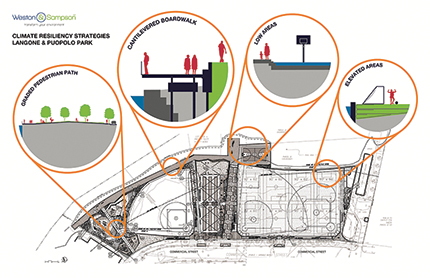
Boston, MA At Langone Park and Puopolo Playground, located along Boston Harbor in the North End neighborhood of Boston, Weston & Sampson is implementing innovative open space climate resilience design. This is the first project within the Boston park system to integrate the standards set forth by the city’s Climate Resilient Design Standards and Guidelines.
Langone & Puopolo has a rich and dynamic history spanning more than a century as one of the oldest parks in the Boston Parks and Recreation system and as the site of the Great Molasses Flood in 1919. This tragic event sparked calls for more regulatory oversight and helped serve as a catalyst for establishing professional licensure and current design practices. Today, the site will put emerging climate change resilience standards to the test.
A key asset that serves not only the North End neighborhood, but also the greater Boston community, Langone & Puopolo is comprised of a children’s playground area and walkways, basketball court, bocce courts, little league baseball field, and a multi-use rectangular field with softball and baseball overlays. The property is the only recreational open space with athletic fields in the North End and also includes a significant length of the Boston’s HarborWalk corridor, a key link that connects Charlestown and Downtown Boston.
While some park assets were renovated over time, several key elements of the 4.5-acre park have deteriorated considerably. Most notable is the seawall that separates the park from Boston Harbor. As climate change and sea level rise become more prevalent and a key challenge to waterfront cities like Boston, open space assets like Langone & Puopolo have been identified as cornerstones to the protection of the city’s edge. Currently, a large section of Langone & Puopolo’s harbor edge is inundated during large storm events and astronomical tides. This project aims to be ground zero for the implementation of open space climate resilience design, serving as a blueprint for future projects.
Weston & Sampson employed a number of climate adaptation strategies including raising the Harborwalk and installing a retaining wall to achieve an elevation of more than 6 feet without walling the site off from the water; stabilizing the existing, degraded seawall with micropilings; capturing stormwater and directing flow through back-flow prevented culverts; and designing courts with lowered elevations and water storage capacity to handle flooding during and immediately after major storm events.








.png)